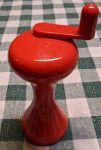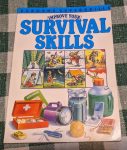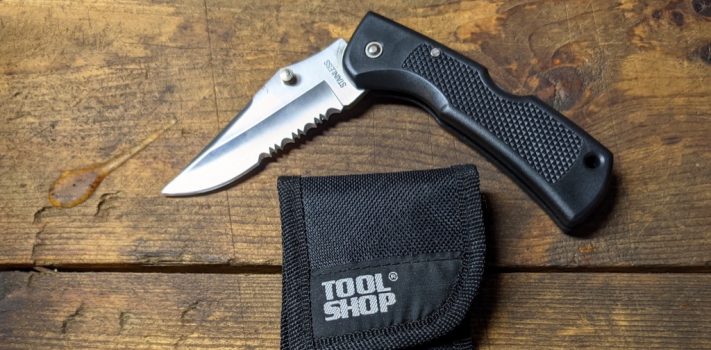I would like to pass along some nutty discoveries for your amusement and edification.
A Flashlight
The IKEA Ljusa hand crank flashlight looks like a gaudy pepper grinder. IKEA originally marketed it as a child’s toy. Why would a prepper be interested in something like this?
The Ljusa is interesting because of the source of its power. The hand crank does not charge a traditional battery. It charges a capacitor instead. This characteristic gives the flashlight a virtually indefinite shelf life, since it has no batteries to degrade over time.
I first became interested in the Ljusa a couple of years ago. My grandson put a flashlight on his Christmas wish list. My daughter and son-in-law requested that the flashlight be rechargeable, so that they would not have to buy new batteries every time my grandson forgot to turn it off. I started researching my options.
 After due consideration, the flashlight that most caught my interested was the Ljusa. My attention was first drawn by the high ratings given to the light by reviewers. They reported that it was good for children because it is durable and not excessively bright. That may sound like a description of my dog, but those qualities are highly desirable in a flashlight for a child. The soft light it produces makes the Ljusa less likely to damage someone’s eyes if a child should happen to shine the flashlight in their face. Its durability allows it to stand up well to abuse by toddlers over extended periods of time.
After due consideration, the flashlight that most caught my interested was the Ljusa. My attention was first drawn by the high ratings given to the light by reviewers. They reported that it was good for children because it is durable and not excessively bright. That may sound like a description of my dog, but those qualities are highly desirable in a flashlight for a child. The soft light it produces makes the Ljusa less likely to damage someone’s eyes if a child should happen to shine the flashlight in their face. Its durability allows it to stand up well to abuse by toddlers over extended periods of time.
The problem that I encountered as I sought to acquire a Ljusa was that they were out of stock everywhere I looked. The flashlight evidently went out of production shortly before I heard about it. In the end, I was forced to buy a different flashlight for my grandson.
Now we can fast forward to the early autumn of 2021. My wife recently had a birthday. I won’t comment on her age. I will merely mention that she is younger and better looking than I am.
After my wife opened her gifts, I asked her what else she would like to do by way of celebration. She indicated that she would like for the two of us to go garage-sale-ing and thrift-store-ing together. So that is what we did.
One of the thrift stores we stopped at contained a delightful surprise. Sitting on a shelf, just as if it was some common, everyday, second-hand item, was a Ljusa in mint condition. It only cost a dollar and a half. I snatched it up, and brought it home for testing.
After arriving home, I searched the internet for a Ljusa manual. IKEA manuals tend to be pretty minimalist, and the one that I found for the Ljusa was no exception. The major information provided by the manual is that 30 turns of the crank fully charges the capacitor, and that this full charge can be expected to produce about 90 seconds of useful light.
I quickly found that it usually takes me less than 10 seconds to fully charge the capacitor by turning the crank 30 times. I also found that in the case of the Ljusa, IKEA had under-promised and over-delivered. It is true that the light is only at its brightest for the first couple of minutes after charging. I estimate this brightness to be about 30 lumens, but did not measure it. But the light continues to shine for a significant period of time even after it begins to fade. Typically this gradually dimming light is available for more than 10 minutes.
This flashlight might not be one’s first choice to use while changing a tire in a driving rainstorm at night, for exploring a cave, or for a host of other uses. But it is an excellent choice for stocking a tornado preparedness kit. There it will provide a readily available, shelf-stable, maintenance-free light source. It is a great kid’s toy as well.
Since the Ljusa is no longer in production, I searched the Internet for other flashlights that use capacitors as their power source. The only capacitor-powered flashlight that I could find that is currently in production is the NightStar Shake Flashlight. I could not justify the expense of buying one for testing since it cost almost $70. So I contacted EcoCentricNow LLC, the manufacturer of the NightStar, to ask if they could provide one for testing and evaluation. The EcoCentricNow representative that replied suggested a review of the Shake Light 40B flashlight instead. The SL40B uses a NiMh battery rather than a capacitor for storage, but beggars can’t be choosers, so I gladly agreed. The representative characterized the SL40B as “a well-constructed, long lasting, human-powered flashlight, which is price point oriented to emergency preparedness, survival, and outdoor recreation audiences.” I hope to provide a review of the SL40B sometime in the coming months.
In the meantime, if anyone has any experience with the version of the NightStar Shake Flashlight that uses a capacitor, I would love to hear more about it. Please write an article, or submit a report to the Snippets column.
A Book
Recently, my wife picked up a book at a thrift store. That book is Improve Your Survival Skills, by Lucy Smith.
Thrift stores are a great source of books for our grandchildren. There is a good selection, and the prices are reasonable.
Prior to Covid, I don’t think that my wife would have given this particular book a second glance. She tolerated my interest in preparing for potential disruptions of life as we have known it, but she did not participate directly in that project herself. The events of the last year and a half have changed her mind. Now she is an increasingly active participant in our preparations.
I was delighted that my wife decided to buy this book, since it was an indication of her growing interest in this important topic. I was equally delighted that there are books like this written to help children prepare for unexpected emergencies.
The particular edition that my wife purchased was published in 1987. I was happy to discover through some online research that the 2008 edition is currently widely available new.
 The book is targeted for children about 11 years of age or so. This 48-page manual gives a good introduction to topics as diverse as shelter, water, adapting to cold weather conditions, adapting to tropical conditions, adapting to desert conditions, water safety, dangerous animals, fire safety, building a fire, urban survival, first aid, self-defense, navigation, rescue, and survival kits. It would even be a good introduction for an adult who has never previously done any reading on the subject. Two sentences early in the book are a good example of the type of practical advice that it provides: “You can greatly improve your survival chances if you try to keep physically fit. Even a half an hour of exercise a day can improve your fitness.”
The book is targeted for children about 11 years of age or so. This 48-page manual gives a good introduction to topics as diverse as shelter, water, adapting to cold weather conditions, adapting to tropical conditions, adapting to desert conditions, water safety, dangerous animals, fire safety, building a fire, urban survival, first aid, self-defense, navigation, rescue, and survival kits. It would even be a good introduction for an adult who has never previously done any reading on the subject. Two sentences early in the book are a good example of the type of practical advice that it provides: “You can greatly improve your survival chances if you try to keep physically fit. Even a half an hour of exercise a day can improve your fitness.”
The advice provided throughout the book reflects a thorough familiarity with real-world problems and useful responses. One weakness of the book is that it does not adequately emphasize the importance of practicing the skills that it describes. For example, it is wonderful to read a description of how to build a fire. It is something else entirely to develop the skill necessary to successfully use that information to build a fire under adverse conditions. The book would be improved by encouraging readers to move beyond theory into actual practice.
In spite of that weakness, this is an excellent book. If you have any children that you would like to introduce to the subject of survival, I heartily recommend it.
A Knife
While my wife and I were celebrating her birthday by garage-sale-ing, I found a “Tool Shop” brand folding knife and pouch at the very first sale that we visited. The knife looked interesting, so I happily paid $3 so that I could take it home and test it further. The knife and pouch contained no identifying markings except for the words “Tool Shop” on the pouch, and the word “Stainless” on the knife. There was no model number, serial number, country of manufacture, or other identifying information anywhere on the product.
The edge of this 3.5-inch lockback blade is half serrated and half plain. There is a thumb stud to assist with opening the blade. The handle is 4.75 inches long, giving an overall length when open of 8.25 inches. The handle is black and appears to be made of nylon.
The knife was sharp enough (barely) to shave hair off my forearm at purchase. It sharpened up extremely well after I got it home.
After sharpening the knife, I brought it out to the barn for further testing. I took it out of the pouch, put a paracord lanyard through the hole in the handle, and hung it on the pegboard over the tool bench. There it is giving good service as the “barn knife.” The barn knife is used to cut cords, strip wires, open boxes, carve wood, and whatever other tasks call for a knife while I am working in the barn. It is serving this purpose better than the Coast FX350 that it replaced. The blade of the FX350 was a little too heavy, and was somewhat difficult to sharpen because of the extreme hardness that the titanium nitride finish imparts to the blade. The slightly thinner and more easily sharpened blade of the Tool Ship knife is more useful as a barn knife.
I am glad that useful tools can often be found at garage sales and thrift stores at reasonable prices. This greatly helps to stretch my preparedness resources.
Disclaimer
I did not receive any financial or other inducements to mention any vendor, product, or service in this article. I had already mentioned the NightStar Shake Flashlight in my draft before EcoCentricNow LLC offered to send me a SL40B for testing and evaluation.










